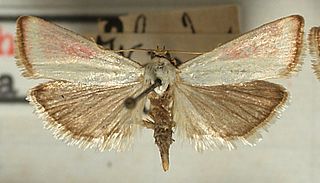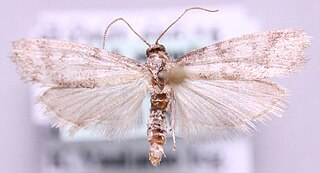
The Pyralidae, commonly called pyralid moths, snout moths or grass moths, are a family of Lepidoptera in the ditrysian superfamily Pyraloidea. In many classifications, the grass moths (Crambidae) are included in the Pyralidae as a subfamily, making the combined group one of the largest families in the Lepidoptera. The latest review by Eugene G. Munroe and Maria Alma Solis, in Kristensen (1999) retains the Crambidae as a full family of Pyraloidea.

The Pyraloidea are a moth superfamily containing about 16,000 described species worldwide, and probably at least as many more remain to be described. They are generally fairly small moths, and as such, they have been traditionally associated with the paraphyletic Microlepidoptera.

Dioryctria sylvestrella, the new pine knot-horn or maritime pine borer, is a moth of the family Pyralidae. It is found in Europe, parts of Asia and North Africa. The adult is a small mottled brown and white insect with a wingspan of 28 to 35 mm. The moth flies in a single generation from June to October and is a pest of maritime pine and several other species of pine, on which the caterpillars feed.

Udea ferrugalis, the rusty dot pearl, is a moth of the family Crambidae. The species was first described by Jacob Hübner in 1796.

Ecpyrrhorrhoe rubiginalis is a species of moth of the family Crambidae. It was described by Jacob Hübner in 1796 and is found in central and southern Europe.
Paracorsia is a monotypic moth genus of the family Crambidae described by H. Marion in 1959. It contains only one species, Paracorsia repandalis, described by Michael Denis and Ignaz Schiffermüller in 1775. It is found in most of Europe, except Ireland, Fennoscandia and the Baltic region. It has also been recorded from central Asia, including Iran and Kyrgyzstan and North America where it has been recorded in southern Ontario and northern Indiana.

Euchromius ocellea, the necklace veneer, is a moth of the family Crambidae described by Adrian Hardy Haworth in 1811. It is a widespread species, found in tropical and subtropical regions, but migrates to Europe.

Ematheudes punctella is a moth of the family Pyralidae described by Georg Friedrich Treitschke in 1833. It is found in southern and central Europe, Turkey and probably further east.

Eurhodope rosella is a moth of the family Pyralidae. It is found in southern and central Europe.

Evergestis frumentalis is a moth of the family Crambidae. It is found from the Iberian Peninsula through southern and central Europe and southern Fennoscandia to central Asia and southern Siberia. The species was first described by Carl Linnaeus in 1761.

Aphomia zelleri is a species of snout moth in the genus Aphomia. It was described by Joseph de Joannis in 1932, and is known from Central Asia and most of Europe.
Bradyrrhoa cantenerella is a species of snout moth in the genus Bradyrrhoa. It was described by Philogène Auguste Joseph Duponchel in 1837 and is known from Morocco and southern Europe.

Vitula biviella is a species of snout moth in the genus Vitula. It was described by Zeller in 1848. It is found in most of Europe, except Ireland and the southern part of the Balkan Peninsula. It is only recently present in Great Britain. The first records were noted in 1997 and 1998 from Kent and the species now seems to have established small breeding populations in both Kent and Suffolk.

Rhodophaea formosa is a moth of the family Pyralidae. It is found in most of Europe.

Phycitodes maritima is a species of snout moth. It is found in most of Europe.

Pyrausta virginalis is a species of moth in the family Crambidae. It is found in southern Europe, Turkey, Armenia and Afghanistan.

Pediasia luteella is a species of moth in the family Crambidae. It was described by Michael Denis and Ignaz Schiffermüller in 1775. It is found in most of Europe. In the east, the range extends to Central Asia, the northern Caucasus, Transcaucasia, southern Siberia and Mongolia.
Euclasta varii is a species of moth in the family Crambidae. It is found in Spain, Algeria, Tunisia, Libya, Angola, the Democratic Republic of Congo, Malawi, Mozambique, Senegal, Sierra Leone, South Africa, Tanzania, Zimbabwe, Zambia and Yemen.

Heliothela wulfeniana is a species of moth in the family Crambidae first described by Giovanni Antonio Scopoli in 1763.
Microthyris lelex is a moth in the family Crambidae. It was described by Pieter Cramer in 1777. It is widespread in the Caribbean, Central America and northern South America. Records include Suriname, Puerto Rico and Jamaica. It has recently been recorded from southern Florida.















